Dear reader: This article contains links to products and services that I may be compensated for, at no extra cost to you.
Pisac (also spelled Písac or Písaq) is one of the largest towns in the Sacred Valley of Peru. The Urubamba River flows through this valley towards the famed Machu Picchu.
As the furthest east town in the valley (or furthest away from Machu Picchu), most visitors bypass Pisac altogether in their rush to get from Cusco to the famous Incan New Wonder of the World. Or, at best, some only stop at Pisac as a part of a Sacred Valley day tour like this one. Usually this only includes an hour or two in Pisac to see the Pisac ruins or the Sunday Pisac Market.
In this article, I will implore you to spend a little more time in Pisac. Although I didn’t love it quite as much as Ollantaytambo, there are enough worthwhile attractions in Pisac to justify spending a few nights there. I personally spent the first 4 days of my trip there and never ran out of things to do.
Below I’ll cover everything you need to know for visiting Pisac, whether you have a few hours or several days there like I did. I personally visited all the places and took all the photos in this article. Also see this article covering my favorite restaurants in Pisac!
Table of Contents
Why Visit Pisac?
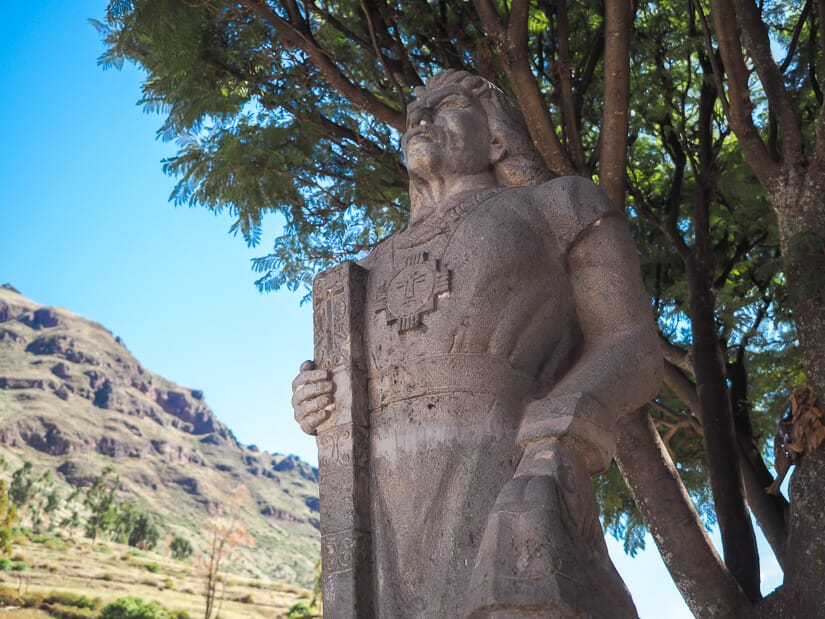
Pisac is home to some of the largest and best-preserved Incan ruins in the Cusco region. The ruins cover a hidden mountaintop, but they include numerous terraced mountain sides that you can see from town. Read my guide to visiting the ruins of Pisac here.
Corn has long been grown in the Pisac area and is often used for making chicha, a mildly alcoholic local drink. Today you can still see many corn farms surrounding Pisac town.

Besides the ruins, Pisac today is mainly famous for its Sunday market, although the market is not as big as it used to be. If you visit on other days of the week, you will just find the usual tourist souvenir markets. But on Sundays, locals come from small villages in the mountains to buy and sell produce, Andean cheese, and other products in the town’s main square.
As the easternmost town in the Sacred Valley, Pisac is actually the closest to Cusco, at just under an hour away by car. But Pisac is nearly 500 meters lower than Cusco in elevation. This makes it a better place to acclimatize if you’re just arriving in the region.

This is precisely why I went directly to Pisac after flying into Cusco. I spent the first 4 days of my trip there (actually my first 4 days in South America!) For me, I know from past experiences in other parts of the world that I am sensitive to altitude.
So even with medication, I experienced some mild altitude sickness in Pisac. I am certain it would have been even worse if I had started in Cusco. Pisac is also significantly smaller and more laid back than Cusco, so that also makes for a better way to start a trip! (for planning your Cusco stay, see my guide to the top things to do in Cusco).
Pisac has a hippie vibe to it, and you will soon notice that it has a resident population of such travelers. If you’re looking for vegan food, yoga classes, cacao & ayahuasca ceremonies, or other such things, this will be your place!
In particular, I noticed that the rural area about 15 minutes’ walk east of the town, on the way to the ruins, has many small hostels and guesthouses catering to visitors interested in such things.
Where to Stay in Pisac

After much consideration, I decided to stay at Wolf Totem Guesthouse (see on Booking / Agoda / TripAdvisor / HostelWorld), which was about 15 minutes east of town. The whole place was hand-built by the eccentric owner Ivan. It has dorms, private rooms, chill-out areas, and a restaurant on site.
There were some very clear ups and downs to my choice. On the upside, my room was totally unique and had an incredible view. It was very quiet and there’s even a small sauna and pool with a view. On the downside, it was a bit of a trek from town, ending with a very steep climb up to the room. There are several rules – none were really problematic for me. But it is essential to look up the rules and read the reviews of this place first to find out if it is the right fit for you.
If you’d rather stay somewhere in town for convenience sake, a few places I seriously considered were Pisac Inn (see on Booking / Agoda / TripAdvisor), right is right on the main plaza, and Hospedaje Familiar Kitamayu Pisac (see on Booking / Agoda / TripAdvisor), which sounds like a very friendly family-run place.
Top Pisac Things to Do
Below are the top sights in Pisac. I started with the most popular attractions, then moved into a few smaller and quirkier things I found to do in my time there. In the following section, I’ll also cover some small day trips I did from Pisac.
Uncover Incan Ruins at Pisac Archaeological Park

The Pisac ruins – or as locals prefer to call them (because “ruins” suggests they are no longer sacred or important), the Parque Arqueológico Pisac (Pisac Archaeological Park) – are the top place to visit in Pisac.
Like many Incan ruins, the site served residential, ceremonial, observational, and military purposes. Although they were historically not quite as important at the Ollantaytambo ruins, I found the Pisac ruins to be more expansive and visually inspiring.
The ruins are situated 20 minutes’ drive north of town, on a mountaintop about 380 meters higher than the town itself. There are two main options for visiting: a shorter and a longer route. I cover both of these routes in great detail in my guide to Pisac Archaeological Park.
To summarize here, for the shorter route, you start and end at the main (upper) entrance, so you’d have a taxi wait for you. Upon entering, you are greeted with an expansive view of the main terraces. Then you visit the ceremonial fountains and Military Zone, including the impressive Amaru Punku (Sun Gate).
You then loop back to the entrance. In total, you might spend about an hour doing this. If you take a Sacred Valley tour, you could expect to see this much of the site.

A longer route would entail walking all the way back to Pisac town, and I recommend this if you have the time and energy. From the peak of the Military Zone, you follow signs to Intihuatana (yes, Pisac has the original Intihuatana, which the one at Machu Picchu was named after).
From there you’ll follow a route taking you through a tunnel, amazing views looking down on Pisac town, the Intihuatana area (which has the finest constructions), the Old Town (Pisaqa) ruins, and finally you’ll spend about an hour walking downhill though many terraces. You’ll end at the Lower Entrance on Intihuatana street. It’s a few blocks north of the northwestern corner of Pisac’s main plaza.

For me, taking the taxi up and walking back down took a total of four hours, but I go very slowly and take lots of notes and pictures. If you move quickly, you could do it in 2-3 hours.
Note that you can also walk up from town, visit the ruins, and walk all the way back down, but this would be a long and intense day or hiking, so only attempt it if you are acclimatized and have done lots of trekking in the area beforehand!
The Pisac ruins can only be visited with the Cusco Boleto Turistico (tourist pass) that includes 16 sights in the Cusco region. The pass is 130 soles or you can buy it online here (valid 10 days).
Or you can visit with the partial pass that only includes Pisac and 3 other sights in the Sacred Valley (70 soles, valid for 2 days). Both passes can be purchased at either entrance to the site – the Lower one in town or Upper one that I recommend starting at.
Budget traveler’s hack: The ticket offices at two main entrances to the Pisac ruins only open at 8 AM. However, the ruins actually open at 7 AM. If you show up between 7 and 8 AM, the guards will let you enter without a pass.
Shop at Pisac Market

Pisac’s second main claim to fame nowadays is its weekly market on Sundays. However, the market is supposedly much smaller today than it used to be. If you’ve visited any other local markets in the region, you won’t find this one much different.
The market takes place on the main square in Pisac (Plaza Constitución). In the past, the market filled the square itself. But now, because it is smaller, and following a recent renovation to the square, the marked only lines the roads on the west, south and east sides of the square, with no stalls in the square itself.

The market attracts local Quechua people from small villages in the Sacred Valley and mountains around it. It is thus great for people watching and photography. The main products being sold are produce, mountain herbs, meat, Andean cheese, small snacks and drinks, and so on. The market starts around 9, peaks around noon, and tapers off in the afternoon.
If you visit Pisac on other days of the week, you will only find the usual and very typical souvenirs for sale. There are whole streets dedicated to these kinds of typical souvenirs here and here in Pisac.
If you’re looking for more authentic and better-quality souvenirs, especially woven products, then I recommend Awana Kancha (see final section below), Manos de la Comunidad (see my Cusco article), or the village of Chinchero instead. None of the souvenirs I saw in Pisac seemed notably better than the souvenirs I saw everywhere else.

Watch Locals Parading out of Pisac Church
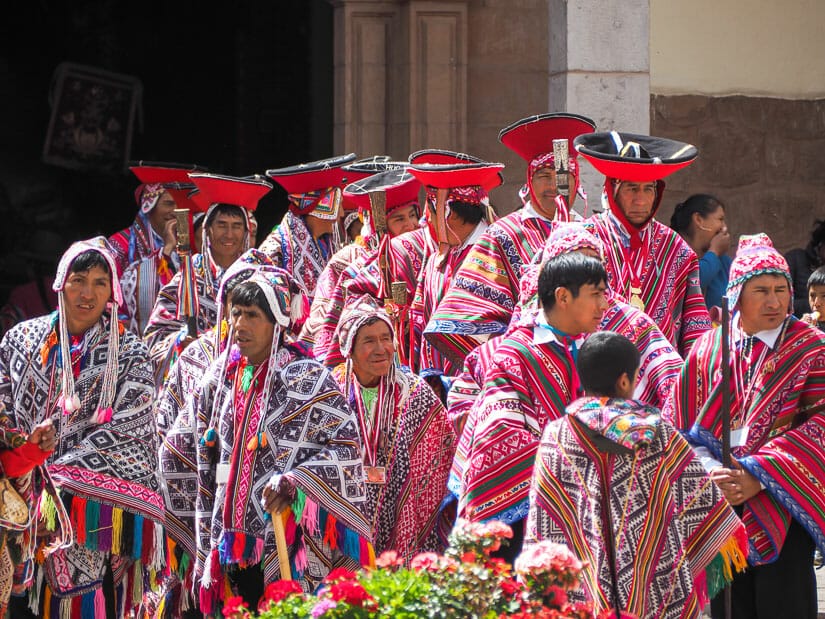
Another reason to visit Pisac on Sunday is this short but colorful spectacle. When locals come Pisac on Sundays, they also attend mass at Iglesia de San Pedro Apostal. This is Pisac’s main church and is located on the north side of Plaza Constitución.
The main church mass starts at 11 AM, and when I visited, it ended at 12:20 PM. When it ends, the locals pour out into the square in procession, led by the most colorfully clad local villages.

I read that the mayor of Pisac sometimes leads the processions. However, when I visited, they actually had all the children at the front, which was very cute, followed by what I assume are the local clan leaders or elders.
The whole thing happens in only a few minutes, but it is a great opportunity for seeing and photographing colorfully dressed local Quechua people.
Have a Meal or Drink Overlooking the Plaza

As the main focal point of Pisac town, it makes sense to grab a drink or meal overlooking Plaza Constitución, especially if you’re there on a Sunday when the square is full of vendors and people.
I tried several of the restaurants overlooking the square and concluded that the best one was La Ruta. This 2nd floor establishment had the most beautifully presented food that I had in Pisac. Their grilled alpaca or trout and ceviche are especially popular. They also have the best patio, facing the church and square directly.
Next door, La Paila was a close second for me. Their “Asian” (sesame flavored) ceviche was one of the tastiest and prettiest versions of ceviche I’ve ever had. The plaza view from the patio is also excellent.
Click here to find other restaurants I enjoyed in Pisac.
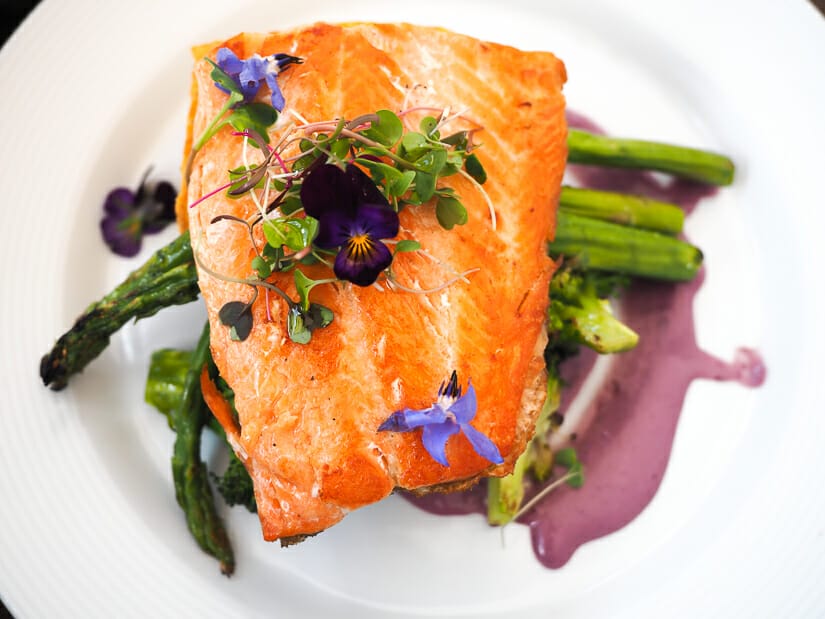
Explore Pisac’s Atmospheric Lanes
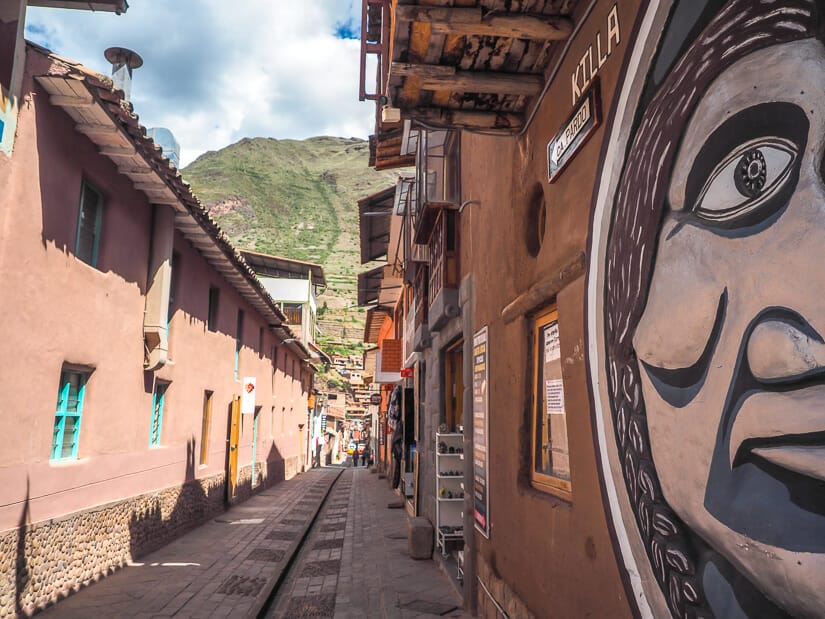
If you’ve got more time in Pisac, then use it to explore any of the lanes leading out from the main plaza. Although it can’t quite compare to the Qosqo Ayllu (Inca old town) of Ollantaytambo, Pisac’s cobblestone lanes are nevertheless atmospheric centers of commerce and activity.
You’ll stumble upon cute cafés, small eateries ranging from local to touristic to vegan, tourist shops galore, and the occasional surprise like this serpent-headed water canal I found:


Learn about Local Plants in Felipe Marin Moreno Botanic Garden

One hidden gem in town is the Felipe Marin Moreno Botanic Garden. A Peruivian botanist created the garden in 1917 and it is now managed by his descendants. It is a quiet oasis filled with dozens of types of local flora, cacti, trees, succulents, and other plants. There’s also a small potato and insect museum inside.
You can access the garden from the gate on Grau street, just a block and a half from Plaza Constitution. Just unlock the gate yourself and enter, and someone will notice you once you’re inside. Entry is 10 soles.
If the garden is closed when you visit or you don’t want to pay the entrance fee, you can also admire it from the large windows inside El Encanto café and restaurant, which is at the northwestern corner of the garden.

Chill out at Restaurant Dona Clorinda

My favorite restaurant in Pisac was Dona Clorinda. It occupies a beautiful house 15 minutes’ walk east of town along the Urubamba River (the walk itself is stunning!)
The restaurant attracts mainly local families (and sometimes local tour buses, but luckily not when I was there), especially for its back yard area and patios. There’s a small playground for kids, while local families toss balls around the yard.

I enjoyed this restaurant for its laid-back, family-friendly atmosphere. It was nice to eat somewhere that local visitors might, rather than the usual international tourist restaurants that most of us eat most of our meals in when visiting Peru. The staff were very welcoming, there’s an expansive menu of local dishes, and the craft beers were excellent.
If you’ve got extra time before returning to town, the lane going north from Dona Clorinda (Tambo de Cozo) was my favorite street in the whole Pisac area. It is lined with elegant wasis (‘houses’ in the Quechua language). Some look like the vacation houses of rich people, while others are guesthouses for tourists, several with an upscale hippie vibe like this one.
Conveniently, this lane led directly to my guesthouse, Wolf Totem! If you walk that far, I also recommend Cerveceria Wayllar for excellent wood fired pizza and craft beer made on site.
Make New Friends at Sacred Sushi & Curry Sunday

Yet another reason to visit Pisac on Sundays is Sacred Sushi and Curry. This is a weekly event aiming to provide a gathering space for everyone and delicious international vegan food. It has been held every Sunday since 2014 (with only a few missed during COVID). You can just drop in for a quick meal (12-6) or come to meet other locals and visitors.
The restaurant/gathering space is in a beautiful garden, with covered and non-covered options. I went for the signature sushi, which had extremely tasty cashew cheese inside, and got the optional sesame sauce and house-made pickled ginger. I had enjoyed a very delicious coconut milk chai.

Sample Local Craft Suds at Sacred Valley Brewery

Sacred Valley Brewery (Cervecería del Valle Sagrado) is the signature beer of the region. The beers are brewed at the Pachar location (see my Ollantaytambo article), but there are taphouses in Cusco, Lima, and of course here in Pisac, too.
I’ve visited them all (I’m a beer geek) and I would have to say that the Pisac taproom was my favorite! There’s a 2nd floor seating area with a variety of cozy chairs and overlooking a huge garden patio with hanging lights and lawn games. I was there early in the day so it was empty. But I’d imagine that it would be great in the late afternoon and early evening, and it seems very family friendly too.
And the beers themselves? The Inti Punku and Apu Veronica IPAs (named after some local ruins and a sacred mountain, respectively) stood out for me!
See the Guinea Pig House at Pumachayoc Horno

Spend any time in the area and you’ll quickly come to learn that they eat a lot of cuy (guinea pigs) here! To see the cute little rodents before they become someone’s dinner, head to Pumachayoc Horno, one of several empanada shops in town.
The empanada shop is connected to a large, pretty courtyard with statues, flowers, and outdoor seating. The guinea pig house can be found in the room at the back – they don’t mind if you enter to see it.
Unfortunately, the empanadas made in the traditional oven here are disappointingly small, overpriced, and bad. For much better ones, go to La Waylaca, which is located right on the souvenir street Mariscal Castilla going east of the northeastern corner of the main plaza in Pisac. They’ve also got beers on tap.
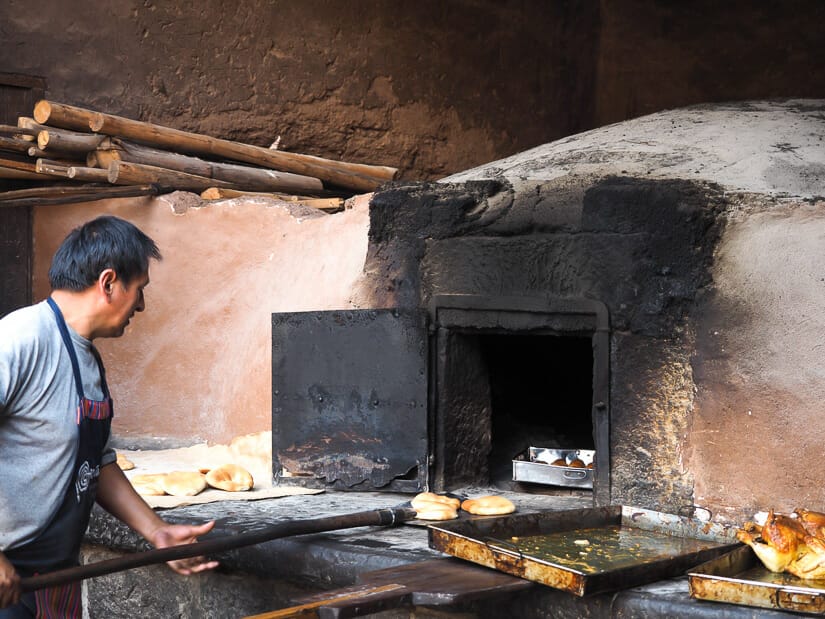
Get Your Picture Taken with a Baby Alpaca

Although it’s such a touristy thing to do, and you’ll feel very much like a tourist when doing so, you know you still want a selfie with one of those cute little guys!
There are almost always a few ladies and/or kids hanging around Plaza Constitution with a baby alpaca or two. They will happily pose for pictures or let you take a selfie with them or their pet. 1 or 2 soles is a reasonable amount to give them after, although they may try to ask you for much more.
If you miss your chance, don’t worry – there are many more of them at Plaza de Armas in Cusco.

Check out the Local New Age Scene

Are you coming to the Sacred Valley mainly for hippie/new age stuff? Or maybe you just want to dabble in it while in town? Then you’ll find a whole lot of it in Pisac. Some of the activities, events, and courses I noted being advertised while I was in town included:
Yoga, healing/huachuma/cacao/ayahuasca ceremonies/retreats, tantric/ecstatic dance, musical oracles, tattoos, sweat lodges, massage, tarot, full moon celebrations, ancestral alchemy, healing touch, and meditation. This list should give you a good idea of the scene you can tap into if you spend more time in Pisac!
It goes without saying that if you’re planning to try something like ayahuasca or huachuma, do some serious research first. Understand exactly what you’re signing up for and things that could possibly go wrong. And if possible, read reviews or take personal recommendations from others when choosing a place.
Other Places to Visit around Pisac
On two of my four days in Pisac, I took little day trips from town. I highly recommend both of them. On one trip, I visited the first three spots below. On another shorter trip, I visited the fourth spot below, but it would have been possible to add more places to it and make it into a full day trip.
Cochahuasi Animal Sanctuary
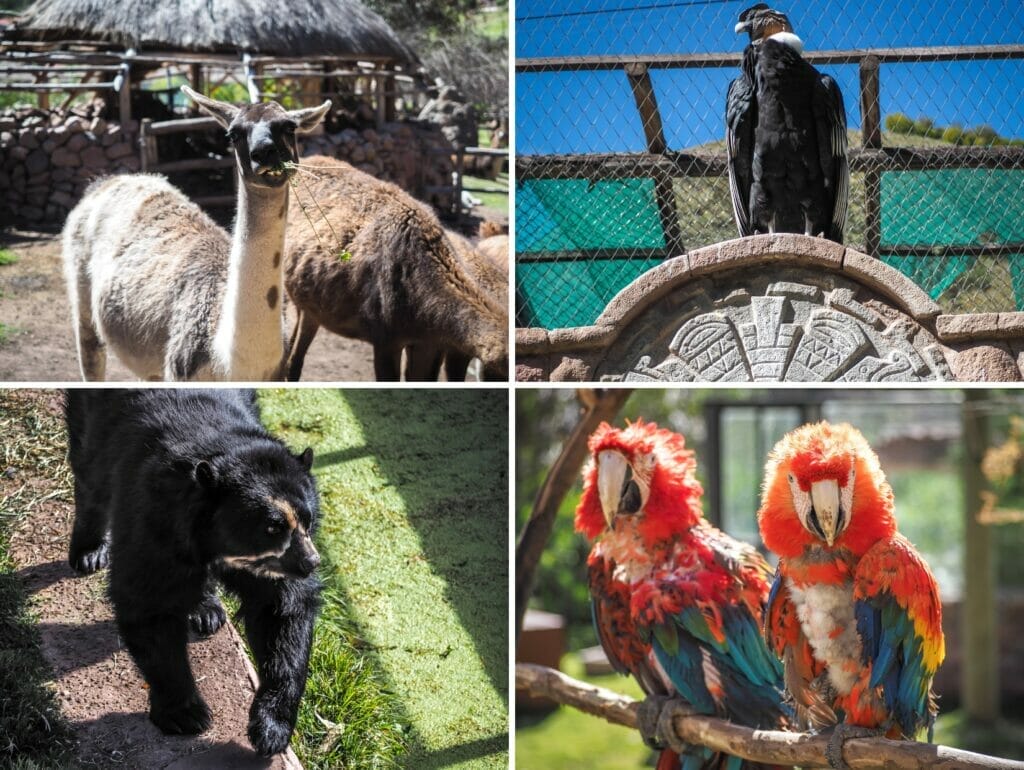
I highly recommend visiting Cochahuasi Animal Sanctuary, which is located on the road between Cusco and Pisac. It’s slightly closer to Pisac than Cusco, but you could also visit it as a day trip from Cusco. Some Sacred Valley tours also stop here.
This is a legitimate animal sanctuary that takes in rescue animals that are injured, have been tortured, and so on. There I saw llamas and alpacas (which I could pet or pose with for pictures), Andean spectacled bears, a puma, small mountain cat, parrots, coati, and condors. For the latter, they even got them to fly for me so I could observe just how huge their wingspan is.
To get to Cochahuasi, I took a Cusco-bound colectivo for only 5 soles from the colectivo station at the south side of Puente Pisac (Pisac Bridge). The ride took 20 minutes. After visiting, I walked all the way back to Pisac (2 hours), stopping at the following two sights on the way. If you don’t want to walk so far, you could just walk to Awana Kancha (less than 5 minutes), then hop on any passing colectivo for getting to Mirador Taray or Pisac.
Awana Kancha

Just a few minutes closer to Pisac from Cochahuasi is Awana Kancha, so it makes sense to visit both of them together. This is a popular weaving center that is also included on many Sacred Valley tours.
If you enter on foot coming from Cochahuasi, then you will first walk through the animal section. There are pens containing many of all four of South Americas camelids: llamas, alpacas, vicuñas, and guanacos.

At the opposite end, and where most people enter if coming by car/tour, is the weaving demonstration area and shop. Here they give visitors demonstrations of weaving, spooling and dyeing thread, and so on. The demonstration was decent but wasn’t as thorough as the one I observed in Chinchero, the famous weaving town, a few weeks later.
The shop on site specializes at higher quality (but also much more expensive) products that you typically find in Pisac town center. There didn’t seem to be a fee for entering when I visited, but you may want to leave a tip for the demonstration guide or in the tip box at the entrance of the animal end of the compound.
Mirador Taray

Mirador Taray, or Taray viewpoint, offers a stunning view of the Taray village and the Sacred Valley. The viewpoint is a one-hour walk (or 8-minute drive) from Awana Kancha (mostly flat), or the same distance/time from Pisac (uphill).
Walking from Awana Kancha to Mirador Taray, I enjoyed some pretty fantastic scenery along the way. The view from the Mirador is especially good – it offers the quintessential Sacred Valley view. You’ll have better sunlight for pictures in the morning, but in the afternoon, you’d be shooting into the sun.
After Mirador Taray, if you decide to keep walking back toward Pisac, you’ll soon reach a series of very long switchbacks descending to Pisac town, with excellent views of the town, Urubamba River, and terraces of the Pisac ruins across the valley.
Museo Inkariy

On another one of my days in Pisac, I decided to make a half-day trip to Museo Inkariy. The trip was so worth it because this ended up being my favorite Inca Museum by a long shot, including the ones at Machu Picchu and in Cusco (learn about all of them in my guide to the best and worst Cusco museums).
What made this museum so good? Well, it covers 8 pre-Columbian civilizations in Peru, going back 5000 years and culminating with the Incas. Unlike other museums I visited, which typically covered a mishmash of artifacts and topics, this one was logically and chronologically divided into 8 areas for each of the civilizations.
Each area had two rooms. In the first, I learned all about that civilization and saw some of their artifacts (mostly replicas, FYI).

In the second room of each civilization’s area, there was a full scale display of humans in dramatic scenes and costumes from the period. Normally these kinds of displays are cheesy at best, but at Inkariy they were so well done that I honestly felt like I was stepping into a set of Indiana Jones and the Temple of Doom (my favorite movie when I was a kid!)
One room in particular was dark and dungeon-like, with chanting and heartbeat sounds. Then I came upon a scene of an Inca performing an elaborate ceremony. In another, I got to see how the Nazca lines might have been used for ceremonies. In yet another, there were tribal elders having a meeting while sitting in stone wall niches like those you see at Machu Picchu and other rooms.

Overall, the museum was information, impactful, well executed, and really brought these scenes from the past to life. It gave me so much more context for what I was seeing when visiting ruins later on my trip.
I also learned so much about how all the previous cultures in Peru contributed to the Inca civilization, which was actually quite short-lived. I’m really surprised that more Sacred Valley tours don’t stop here – the only other visitors I saw were local school groups.
The museum is located just past the town of Calca, about 45 minutes west of Pisac by colectivo (5 soles). If you’re traveling from Pisac to Ollantaytambo, you could visit Museo Inkariy on the way. The museum is also included on this Sacred Valley tour.

Other Possible Day Trips from Pisac
If you’re staying in Pisac for longer, there are other possible day trips you could make besides the ones I mentioned above. Here are just a few that you could consider:
- Kinsa Concha: A beautiful alpine lake with hiking trail around it. About 35 minutes’ drive north of Pisac
- Huchuy Qosqo: A very steep/difficult hike to some of the most important ruins in the Sacred Valley. The hike starts from Lamay (30 minutes’ drive west of Pisac). It’s also possible to walk to the ruins from Chinchero, coming from the other side, which is not so steep.
- Baños de Machacancha: Some hot spring pools north of Calca
- Urubamba: the largest town in the Sacred Valley, but it has fewer things to see or do for visitors. There are still a few, though. See my Sacred Valley guide for more info. You could also visit Urubamba on the way from Pisac to Ollantaytambo.
Well, folks, that bring us to the end of my Pisac guide! I hope you’ve found more than enough things to do in Pisac to make the best of your visit. Let me know in the comments below if I’ve missed anything!

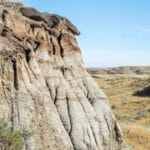


Thank you Nick for your excellent blog which has been a great source of valuable information and tips while planning our trip to Pisac. You’re the best!